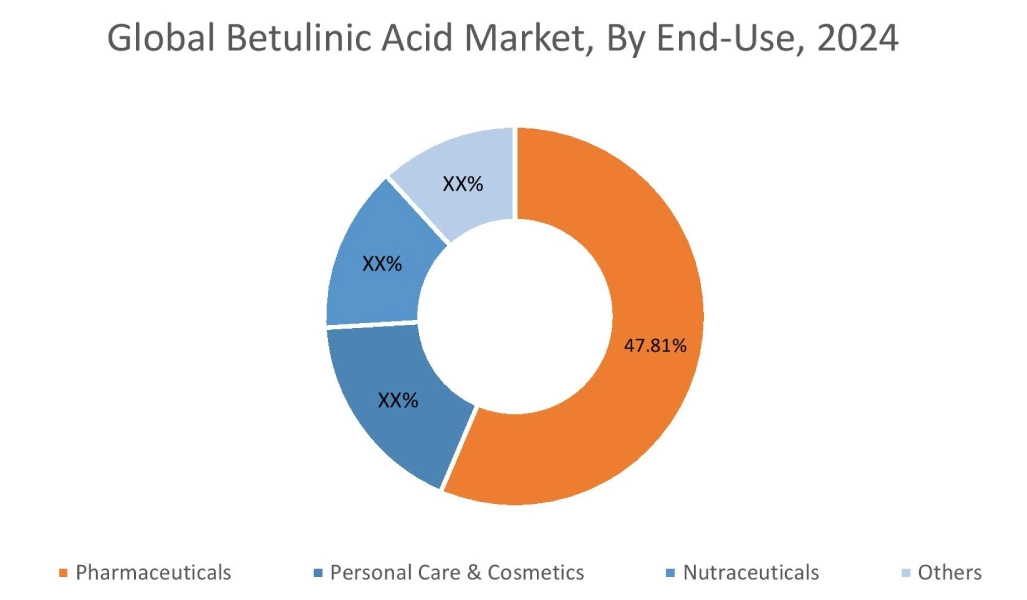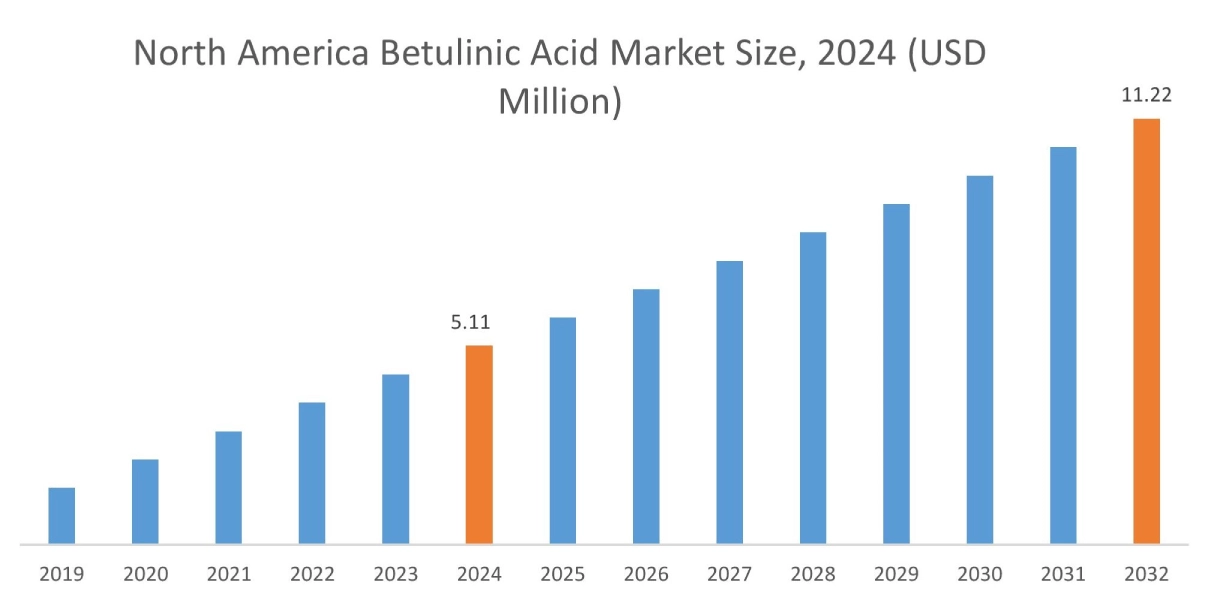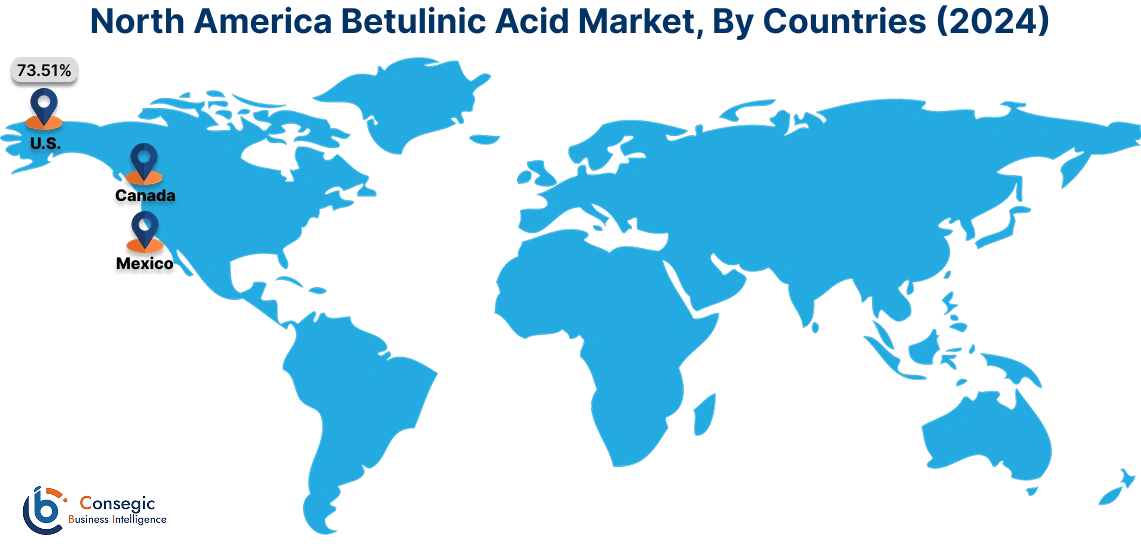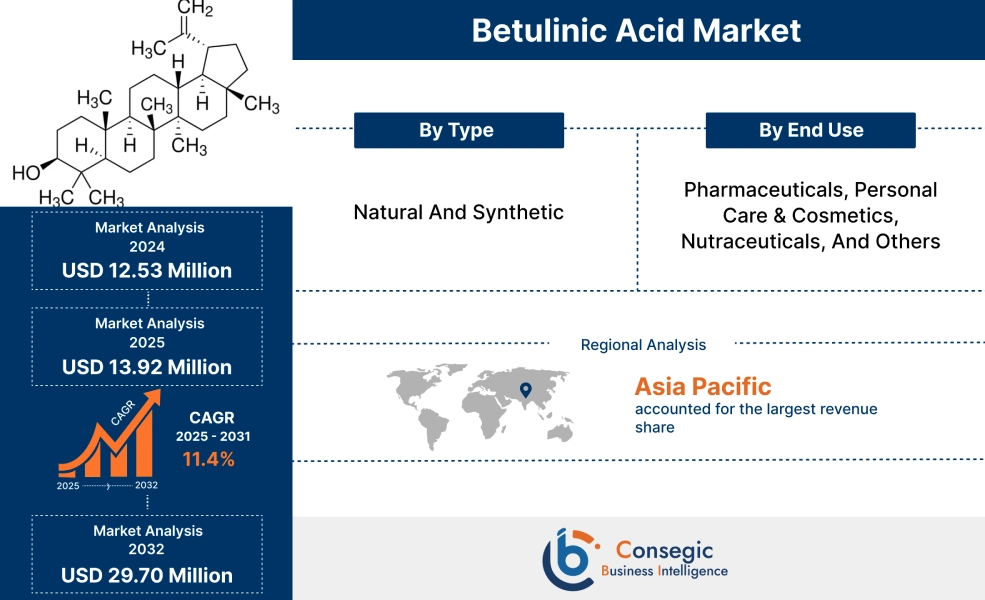Betulinic Acid Market Size:
Betulinic Acid Market size is growing with a CAGR of 11.4% during the forecast period (2025-2032), and the market is projected to be valued at USD 29.70 Million by 2032 from USD 12.53 Million in 2024. Additionally, the market value for the 2025 attributes to USD 13.92 Million.
Betulinic Acid Market Scope & Overview:
Betulinic acid (BA) is a naturally occurring pentacyclic triterpenoid. It is primarily extracted naturally from the bark of birch trees. This involves processes such as solvent extraction followed by purification. It is also present in other plants such as the ber tree, Ziziphus spp., and selfheal among others. It is also produced synthetically from its precursor, betulin. This typically involves selective oxidation of betulin. Moreover, Emerging methods such as microbial biosynthesis, where microorganisms like yeast are engineered to produce betulinic acid. It exhibits a variety of biological activities. This includes antibacterial, antimalarial, anti-inflammatory, anthelmintic, and antioxidant properties.
Betulinic Acid Market Dynamics - (DRO) :
Key Drivers:
Rising Prevalence of Chronic Diseases is Accelerating Betulinic Acid Market Expansion.
Betulinic acid has excellent biological activities. It alleviates inflammation and is beneficial in reducing oxidative stress. This treats conditions such as psoriasis, inflammatory bowel disease, and rheumatoid arthritis among others. Moreover, it helps neutralize harmful free radicals, which helps in reducing cellular damage. Additionally, it has a superior ability to cross the blood-brain barrier. This makes it valuable for neurological disorders such as Alzheimer's and Parkinson's. Furthermore, it induces apoptosis in various cancer cells. This offers a natural therapeutic avenue. Sedentary habits, poor nutrition, and lifestyle choices have led to an increase in the prevalence of these chronic diseases, hence requiring this acid to treat these conditions.
For instance,
- According to the Centers for Disease Control and Prevention, 54.4 million adults in the United States (20.7%) have been diagnosed with arthritis, thus positively impacting betulinic acid market trends.
Overall, the rising prevalence of chronic disease is boosting the betulinic acid market expansion.
Increasing Demand for Skincare Products is Driving the Market.
Betulinic acid boosts collagen production. This helps reduce the appearance of fine lines and wrinkles while improving overall skin texture. It also helps strengthen and protect the skin barrier. This is crucial for preventing moisture loss and protecting the skin from environmental stressors. Moreover, it is helpful in reducing inflammation and protecting against free radical damage. This prevents skin from aging. Additionally, it has the ability to promote keratinocyte migration. This aids in skin healing and regeneration. Furthermore, it helps manage skin microorganisms. This potentially contributes to reduced acne and other skin issues. Rising awareness of skincare routines and a growing focus on self-care have led to an increased demand for skincare products, hence requiring this acid for products such as serums, moisturizers, and masks.
For instance,
- According to Cosmoprof, the sales of luxury skincare products in the U.S., increased by 18% in year 2021, when compared to 2020, thus positively impacting betulinic acid market trends.
Thus, the increasing demand for skincare products is accelerating the global betulinic acid market growth.
Key Restraints:
Growing Commercialization of Alternatives is Hampering the Betulinic Acid Market Demand
The market faces competition from other substitutes available in the market. For instance, ursolic acid and oleanolic acid are more cost-effective to extract. They also possess anti-inflammatory, antioxidant, and potential anticancer properties. This makes them suitable for similar cosmetic and nutraceutical applications. Moreover, curcumin serves as a powerful natural anti-inflammatory and antioxidant. It is well researched while providing excellent benefits in reducing systemic inflammation and oxidative stress. This makes it widely utilized in pharmaceutical and nutraceutical applications. Hence, the growing commercialization of substitutes is hampering the betulinic acid market demand.
Future Opportunities :
Growing Production of Dietary Supplements is Expected to Increase Betulinic Acid Market Opportunities.
Betulinic acid is increasingly being incorporated into dietary supplements. It is helpful in activating AMPK, which is a key enzyme involved in energy metabolism. This contributes to antiobesity effects. Moreover, it has immunomodulatory effects. This strengthens the immune system and contributes to overall well-being. Additionally, it prevents abdominal fat accumulation and mitigates high-fat diet-induced obesity. Furthermore, it enhances antioxidant activity. This makes it a potential dietary strategy for managing metabolic syndrome. A shift towards preventive healthcare has led to increased need for dietary supplements, creating potential for the market.
For instance,
- For instance, according to Vitaquest, the global dietary supplements market is expected to grow at a CAGR of 6.7% between 2022 and 2032.
Overall, the growing production of dietary supplements is expected to increase the betulinic acid market opportunities.
Betulinic Acid Market Segmental Analysis :
By Type:
Based on type, the market is categorized into natural and synthetic.
Trends in Type:
- The clean label trend is significantly driving the need for natural BA in anti-aging cosmetic formulations.
- The pharmaceutical sector often favors synthetic betulinic acid due to its higher purity, consistent supply, and scalability for drug development.
The synthetic segment accounted for the largest market share in 2024.
- Synthetic types allow for precise control over the chemical structure. This leads to the extraction of higher purity levels of BA.
- It also ensures consistent batch-to-batch quality. This is critical for drug development and regulatory approval.
- Chemical synthesis methods are scaled up to meet industrial demands. They are not subject to seasonal variations, climate conditions, or geographic limitations of natural raw materials. This ensures a stable supply.
- Moreover, synthetic production results in fewer unwanted impurities compared to natural extracts.
- Additionally, the controlled environment of synthesis allows manufacturers to easily modify chemical formulations. All these benefits are driving its increased usage in the pharmaceutical industry.
- Overall, as per the market analysis, the aforementioned factors are driving a segment in the betulinic acid market growth.
The natural segment is expected to grow at the fastest CAGR over the forecast period.
- Natural betulinic acid is perceived as safer by consumers when compared to synthetic counterparts.
- Natural extracts are less harsh than synthetic chemicals. This is a significant marketing advantage in sensitive product categories such as skincare.
- Being naturally derived resonates strongly with the growing consumer preference for naturally sourced ingredients in cosmetics and dietary supplements, thus driving segment share.
- For instance, as per the survey analysis provided by Milieu in 2023, it is stated that 66% of Southeast Asian consumers prioritize natural ingredients in skin care products.
- According to betulinic acid market analysis, the aforementioned factors will drive segmental growth for the upcoming years.
By End Use:
Based on end-use, the market is categorized into pharmaceuticals, personal care & cosmetics, nutraceuticals, and others.
Trends in the End-Use
- The pharmaceutical sector is driving betulinic acid demand in ongoing research and development for anticancer therapies.
- There is a growing trend of using betulinic acid in premium anti-aging and soothing skincare formulations.
The pharmaceuticals segment accounted for the largest market share of 47.81% in 2024.
- BA has high anti-tumor activity. It is particularly in melanoma and inhibits the proliferation of various tumor cell lines. This includes those from prostate, neuroblastoma, colon, breast, and lung cancer.
- Moreover, it has potent activity against HIV, with some derivatives even being tested in clinical trials.
- Additionally, it also exhibits anti-inflammatory, antibacterial, antimalarial, and antioxidant properties.
- Furthermore, its water solubility and bioavailability have encouraged research into new drug delivery systems.
- It includes nanoparticles, liposomes, and micelles, among others. This will improve its targeting and efficacy.
- Overall, as per the market analysis, the aforementioned factors are driving the segment in the betulinic acid industry.
The nutraceuticals segment is expected to grow at the fastest CAGR over the forecast period.
- Betulinic acid is found in various foods and plants, including sour jujube fruits, papaya, and persimmon.
- It has excellent anti-inflammatory properties. This makes it a valuable ingredient in joint support tablets.
- Moreover, this naturally occurring triterpenoid plays a crucial role in a healthy diet. It helps with weight management and improves non-alcoholic fatty liver disease, making it crucial in dietary supplements as well.
- A shift towards natural and holistic wellness solutions has led to industry growth, creating potential for the market.
- For instance, according to the Indian Ministry of Food Processing, the Indian dietary supplements market is expected to grow at a CAGR of 22% from 2020 to 2026.
- Thus, according to market analysis, the aforementioned factors will drive segmental growth for the forecasted years.

Regional Analysis:
The regional segment includes North America, Europe, Asia Pacific, the Middle East and Africa, and Latin America.

In 2024, North America accounted for the highest betulinic acid market share at 40.78% and was valued at USD 5.11 Million and is expected to reach USD 11.22 Million in 2032. In North America, the U.S. accounted for the betulinic acid market share of 73.51% during the base year of 2024. Consumers in the region are becoming highly conscious of skin health and appearance. This is a driving need for innovative and effective personal care and cosmetic solutions. This has also led to robust sales of skincare products across the region.
For instance,
- For instance, according to Happi, U.S. skincare product sales have increased by 10% in the last five years.

Betulinic acid benefits in stimulating collagen synthesis and reducing inflammation. It also provides necessary antioxidant protection. This aids in skin brightening. Moreover, this acid has been increasingly incorporated into premium products such as serums, moisturizers, and face masks. Overall, the growing personal care and cosmetics sector is driving the market in the region.
In Asia Pacific, the betulinic acid market is experiencing the fastest growth with a CAGR of 13.3% over the forecast period. The market in the region is driven by advancements in extraction and purification technologies. This region, with its rich biodiversity and established herbal medicine traditions, is a hub for research and development in natural product extraction. Innovations such as supercritical fluid extraction (SFE), and microwave-assisted extraction (MAE) are becoming more prevalent in APAC. These advanced techniques are beneficial in offering higher yields and improved purity. They are also reducing processing time while lowering solvent consumption compared to conventional methods. This makes it more accessible for various applications.
Europe's betulinic acid market analysis indicates that several key trends are contributing to its growth in the region. There is an increasing need for natural ingredients across various product categories such as nutraceuticals in the region. European consumers exhibit a strong preference for products that are natural, organic, and free from synthetic chemicals. This aligns with a broader trend towards healthier and more sustainable living. Betulinic acid is a naturally occurring compound. It is a pentacyclic triterpenoid found in the bark of a white birch tree.
The Middle East and Africa (MEA) market analysis indicates that there is rising prevalence of chronic disease in the region. Betulinic acid is used in anti-HIV medicines. Moreover, given the widespread burden of malaria in MEA countries, this acid is also used in drug development. Additionally, its broader antiviral properties are gaining attention in various viral outbreaks. Also, its anti-inflammatory effects make it valuable in managing inflammatory conditions such as arthritis.
Latin America's region creates potential for the market. There is growing investment in cancer research within the region. They are actively expanding their oncology research capabilities. Institutions such as LACOG and the National Cancer Institutes in countries such as Brazil and Argentina are conducting more clinical trials focused on novel cancer therapies. Betulinic acid's well-documented anticancer properties, including its ability to induce apoptosis in various cancer cell lines, make it a prime candidate for these investigations.
Top Key Players and Market Share Insights:
The Betulinic Acid market is highly competitive with major players providing products to the national and international markets. Key players are adopting several strategies in research and development (R&D) and product innovation to hold a strong position in the global Betulinic Acid market. Key players in The Betulinic Acid industry include-
- Selleck Chemicals (United States)
- AG Scientific (United States)
- Xi'an Huilin Bio-Tech Co., Ltd. (China)
- BPS Bioscience (United States)
- LGC Standards (United Kingdom)
- Merck KGaA (Germany)
- Adooq Bioscience (United States)
- Huanwei Biotech (China)
- StressMarq Biosciences, Inc. (Canada)
- Cayman Chemical (United States)
Betulinic Acid Market Report Insights :
| Report Attributes | Report Details |
| Study Timeline | 2019-2032 |
| Market Size in 2032 | USD 29.70 Million |
| CAGR (2025-2032) | 11.4% |
| By Type |
|
| By End-Use |
|
| By Region |
|
| Key Players |
|
| North America | U.S. Canada Mexico |
| Europe | U.K. Germany France Spain Italy Russia Benelux Rest of Europe |
| APAC | China South Korea Japan India Australia ASEAN Rest of Asia-Pacific |
| Middle East and Africa | GCC Turkey South Africa Rest of MEA |
| LATAM | Brazil Argentina Chile Rest of LATAM |
| Report Coverage |
|
Key Questions Answered in the Report
How big is the Betulinic Acid market? +
In 2024, the Betulinic Acid market is USD 12.53 Million.
Which is the fastest-growing region in the Betulinic Acid market? +
Asia Pacific is the fastest-growing region in the Betulinic Acid market.
What specific segmentation details are covered in the Betulinic Acid market? +
Type and End-Use segmentation details are covered in the Betulinic Acid market.
Who are the major players in the Betulinic Acid market? +
Selleck Chemicals (United States), AG Scientific (United States), Merck KGaA (Germany), Adooq Bioscience (United States), Huanwei Biotech (China), and StressMarq Biosciences, Inc. (Canada) are some major players in the market.


